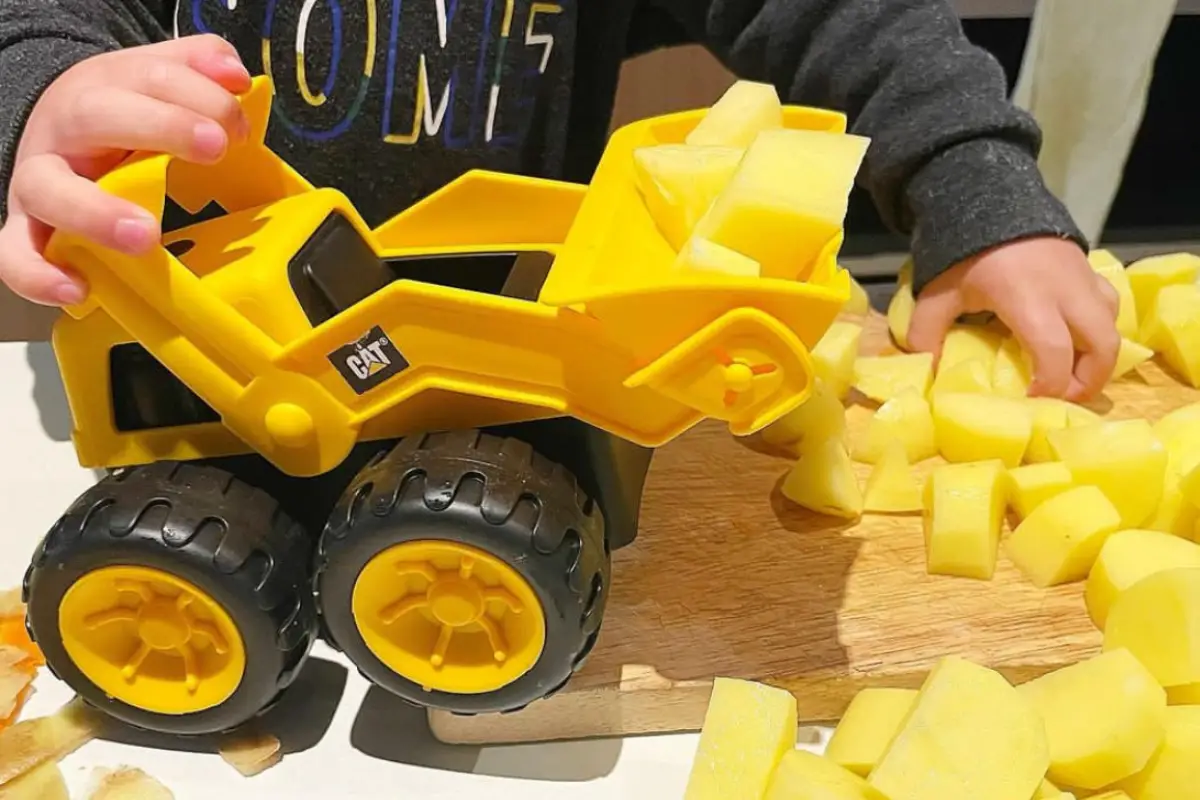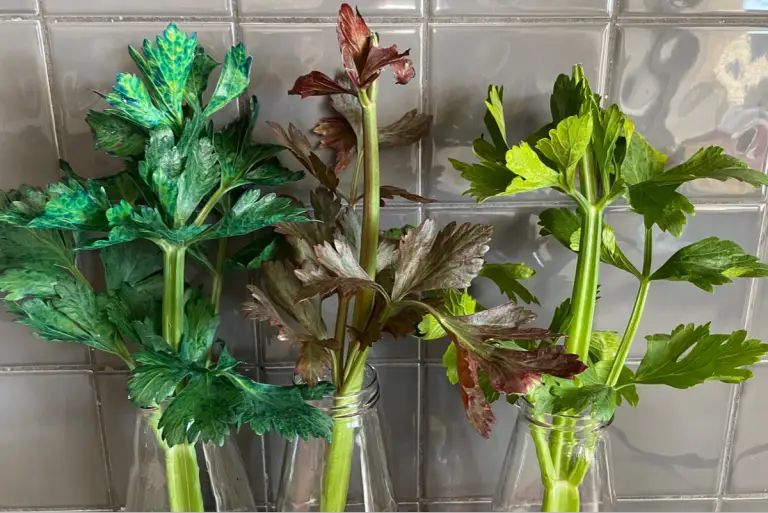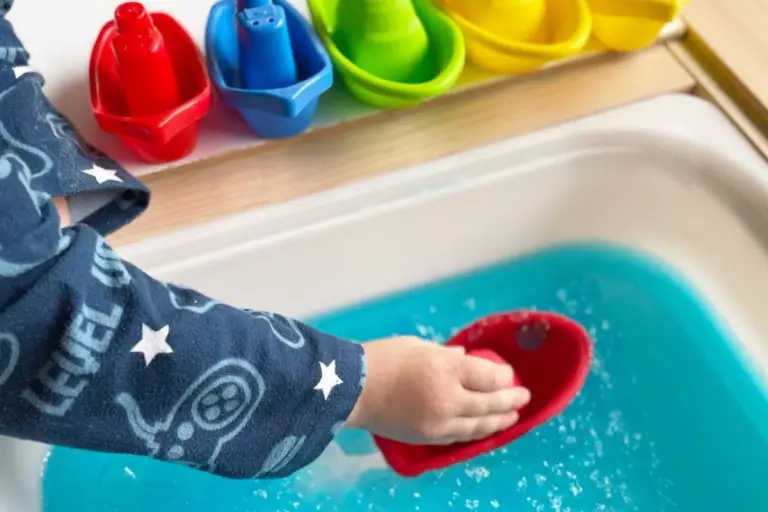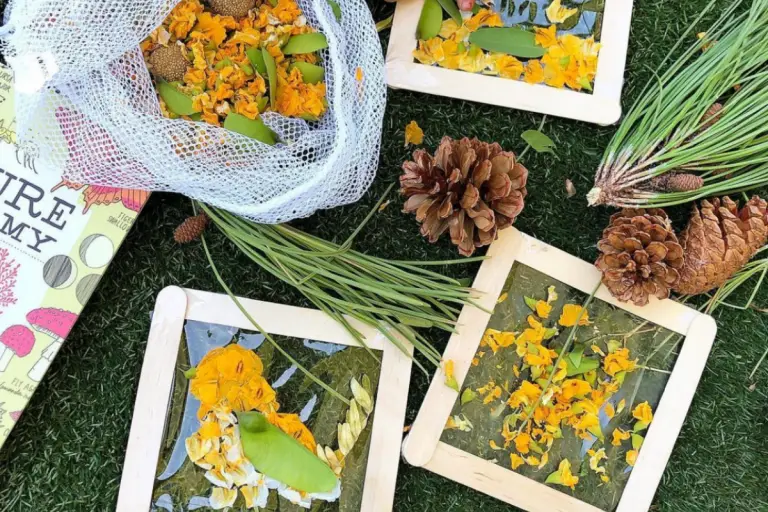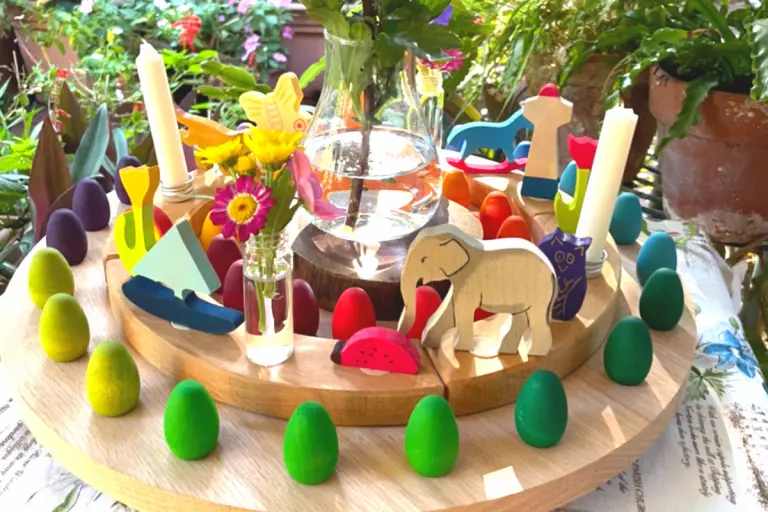Tops & Peels Playtime: Eco-friendly Sensory Fun with Construction Trucks
Disclosure: This blog contains affiliate links which I may earn a small commission from if you purchase through them, at no extra cost to you.
Dinner prep turned into an impromptu play time with some tops and peels sensory fun.
Kids are non stop, ‘play with the box more than the toy that came in the box’.
This is a perfect example of why kids don’t need all the fancy toys, bells and whistles.
Simple play can be the best and most engaging.
Today, sensory play presented itself and while it certainly wasn’t planned, it has highlighted a play material that I would certainly never have thought of myself.
Before turning your kitchen scraps into compost, why not use them for some sensory play.
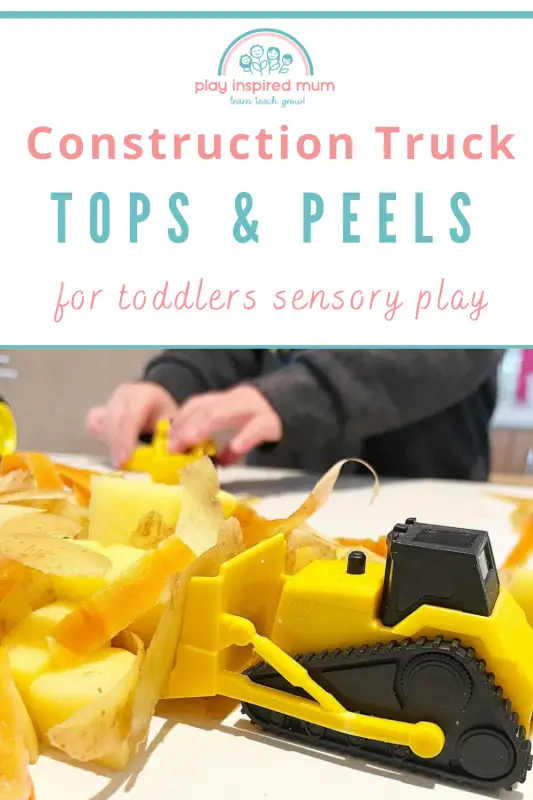
Tops and Peels Sensory Play
I’ve discovered the magic of sensory play and its pivotal role in toddlers’ growth.
It’s more than just a mess.
Sensory play a gateway to exploration and learning.
For those little ones obsessed with construction trucks, adding these toys to sensory play sessions elevates the experience.
I merged the worlds of sensory exploration and childhood fascination by incorporating construction vehicles into playtime.
Well truth be told it was all Mr 3 and his love of construction vehicles fuelling his play.
This combination provides an engaging, educational, and eco-friendly play setup.
It not only captivates their attention but also fuels their imagination through tangible interactions with diverse textures and shapes.
Carrot tops, potato peels, and onion skins transform into a construction site, making every play session an adventure in organic play.
Why Construction Trucks?
I noticed how construction vehicles immediately captivate toddlers.
They seem drawn to them like bees to flowers. In their eyes, these toys are not just trucks but entire worlds of adventure and learning.
By incorporating construction trucks into sensory play, we unleash a myriad of developmental benefits.
These include fine motor skill improvement and a heightened understanding of cause and effect.
Engaging toddlers with carrot tops, potato peels, and onion skins alongside their favorite construction vehicles envelopes their play in a rich, taste-safe sensory experience.
Sensory play activities, especially with elements familiar from helping prepare dinner, not only bridge the gap between play and real-life tasks but also invite toddlers to explore texture, weight, and balance in an organic play setting.
This fusion of play and learning sets the foundation for important early cognitive and physical development.
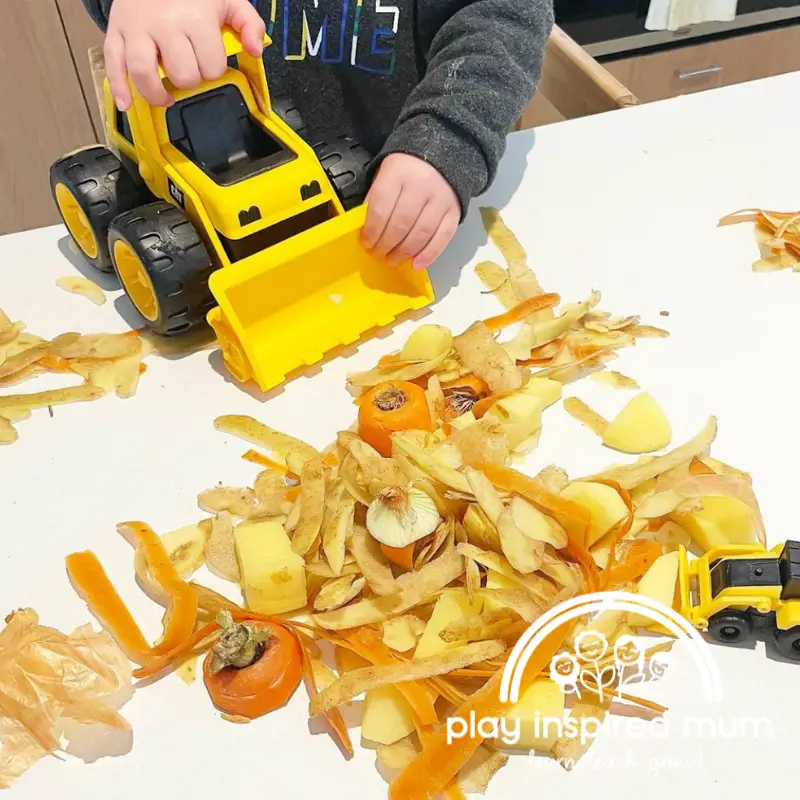
Gathering Your Materials
I’ve always been a fan of finding new ways to incorporate organic play into our daily routine.
We often adopt inspiration from Montessori method of learning by involving children in day to day activities; practical life skills.
One afternoon, Mr 3 was helping prepare dinner when he saw an opportunity for play that I thought was genius.
This task required a shift in perspective, seeing value in what many would toss into the trash.
Utilizing carrot tops, potato peels, and onion skins for sensory play wasn’t just about keeping my toddler entertained.
As he scampered down his learning tower, I questioned where he was going.
He had a face of determination and knew exactly what he was doing.
When he returned, his arms held his trucks and his face held a huge smile.
As soon as his trucks got to work, powered by busy hands and a little boys imagination, I just laughed.
It was brilliant!
The materials list was simple yet profound.
Carrot tops, full of texture and colour, alongside potato peels, perfect for soft, tactile sensations. Onion skins, with their crinkly nature, added an auditory dimension.
Each of these elements, paired with a child’s fascination with construction vehicles, transformed our playtime into an eco-friendly adventure.
It was about embedding eco-consciousness into his play, all while ensuring it was taste safe.
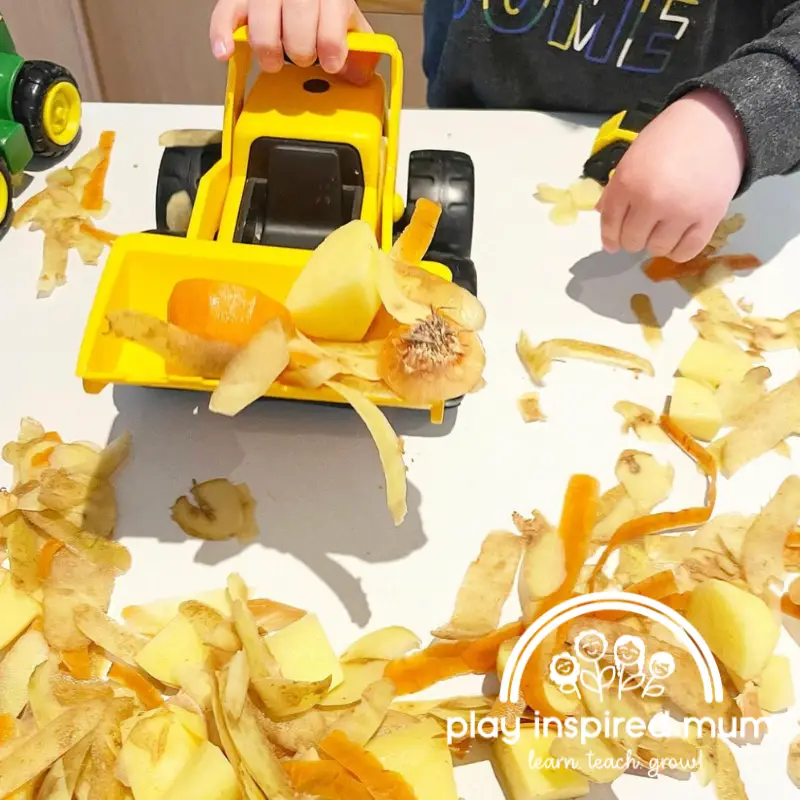
Engaging with Construction Trucks
Mr 3 gathered all the carrot tops, potato peels, and onion skins from our kitchen.
These were going to be the bulk of his sensory material.
Next, he picked construction vehicles he absolutely adores.
Dump trucks and excavators from his toy collection were perfect for this task.
We laid out an old sheet to catch any stray bits, ensuring clean-up would be a breeze later on.
- Introduce the trucks to the sensory bin: Start by placing the construction vehicles around the edge of your sensory bin filled with compostable kitchen scraps.
- Encourage free play: Let your toddler take the lead. They may begin by exploring the textures of the carrot tops, potato peels, and onion skins before integrating the construction trucks.
- Guide their exploration: Show them how a dump truck can be filled with peels and driven to another part of the play area. Suggest they might want to scoop up onion skins with an excavator.
Each step was designed to ignite their senses and fuel their love for construction vehicles, all while keeping the play taste safe and eco-friendly.
Taste Safe Sensory Play
Ensuring that sensory play remains a safe experience for toddlers is paramount, especially when they are so prone to explore the world with their mouths.
That’s where taste safe sensory play comes into play. I meticulously chose carrot tops, potato peels, and onion skins for our construction adventure.
These materials, often discarded, became valuable tools for exploration, allowing peace of mind knowing they were free from harmful chemicals.
Not only did this emphasize the importance of organic play, but it also taught me to view kitchen scraps in a new light.
By doing so, I offered a sensory experience that was as safe as it was educational.
Ensuring every bit of our playtime was both eco-friendly and taste safe wasn’t just a choice; it was a commitment to fostering a secure and stimulating environment for discovery.
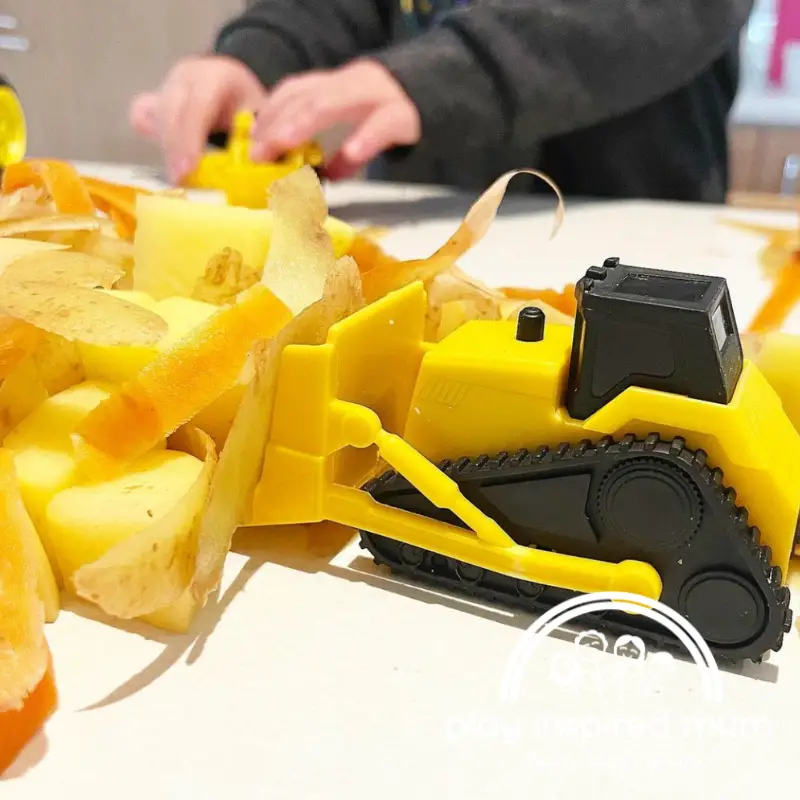
Extending the Fun Beyond Playtime
I found that our sensory play with construction trucks, carrot tops, potato peels, and onion skins not only entertained but also taught us a valuable lesson in sustainability.
After our playtime, we didn’t just toss everything into the trash.
Instead, I showed my toddler how we could give these materials another life.
We took those potato peels, carrot tops, and onion skins and added them into our compost tumbler for our garden.
It was a tangible way for us to contribute to the cycle of growth.
Composting became an extension of our play, reinforcing the importance of organic play and how even our playtime choices can impact the environment.
This experience helped instill in my child an early awareness of composting and organic materials’ role in reducing waste.
The idea that our sensory play activities could lead to helping our plants grow fascinated us both.
This method allowed us to extend the fun beyond just playing and turned it into a learning experience about eco-friendly practices.
By engaging in sensory play that’s both taste safe and environmentally conscious, we can teach our toddlers the value of organic play and the importance of sustainability from a very young age.

Benefits of Sensory Play with Everyday Items
I discovered that using everyday items like carrot tops, potato peels, and onion skins in sensory play was not just about keeping my toddler entertained.
It was a gateway to fostering creativity.
By supporting him in using compostable kitchen waste alongside his construction vehicles, he found a way to spark his imagination, and it was celebrated.
He would invent new ways to interact with these materials, turning a pile of peelings into a bustling construction site.
The benefits extended beyond just a fun afternoon.
This approach to sensory play helped instill an early sense of environmental responsibility.
My toddler learned that not everything needs to come from a store to be valuable for play, and some of the best toys are the ones we make ourselves from what we already have.
Engaging in sensory play with carrot tops, potato peels, and onion skins offered a taste-safe option.
This reassured me as he explored textures and shapes with both his hands and mouth.
These activities supported developmental milestones.
They encouraged fine motor skills, problem-solving, and sensory processing.
Each interaction was a lesson in texture, weight, and color, contributing to his cognitive growth.
Let’s Wrap Up This Mess-Free Adventure
We drove into a world where carrot tops, potato peels, and onion skins became the backdrop for an eco-friendly adventure.
Our construction trucks roared through these compostable materials, crafting a playtime that was as enriching as it was imaginative.
Along the way, sensory play ideas flourished, blending the joys of taste safe sensory play with the thrill of construction vehicles.
Integrating organic play into our day proved transformative.
Not only did it afford a platform for sensory play activities that captivated and educated, but it also allowed us to weave in important lessons on composting and environmental responsibility.
This adventure underscored the value of using everyday items, highlighting how toddler activities can be both sustainable and engaging.
Encouraging our little ones to help prepare dinner with these organic materials, watching their fascination as they explore, offers an unparalleled opportunity.
It transforms playtime into a session rich with sensory play and learning.
For those of us construction truck obsessed, crafting sensory play with these materials opened up new avenues for creativity and fun.
If you’re on the hunt for toddler activities that engage, educate, and echo the principles of eco-friendly living, this tops and peels playtime is the perfect fit.
So, gather those peels, summon your fleet of trucks, and set the stage for a memorable, mess-free adventure.
It’s a wonderful way to interlace play, learning, and love for our planet in your daily routine.

